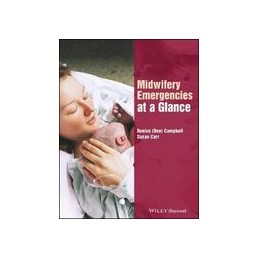- Reduced price

Order to parcel locker

easy pay


 Delivery policy
Delivery policy
Choose Paczkomat Inpost, Orlen Paczka, DHL, DPD or Poczta Polska. Click for more details
 Security policy
Security policy
Pay with a quick bank transfer, payment card or cash on delivery. Click for more details
 Return policy
Return policy
If you are a consumer, you can return the goods within 14 days. Click for more details
Midwifery Emergencies at a Glance is a succinct, illustrated guide covering the practical skills needed to manage obstetric and midwifery emergencies, as well as high-risk midwifery care. It provides clear guidance on the factors which predispose to complications so that preventative management can be employed whenever possible. Broad-ranging yet easy-to-read, Midwifery Emergencies at a Glance details the underlying physiology and pathophysiology related to the emergency and explores both the physical and psychological care of the woman, partner and newborn during and following the emergency.
Key features::
Midwifery Emergencies at a Glance is an ideal guide for practising midwives, pre-registration student midwives, general practitioners and junior doctors to support both revision and clinical practice.
Data sheet
Preface viii
Abbreviations ix
About the companion website x
Part 1 Professional issues 1
Section 1 Professionalism
1 Professional standards 2
2 Communications during an emergency 4
Part 2 Emergency skills 7
Section 2 Resuscitation
3 Maternal resuscitation 8
4 Neonatal resuscitation 10
Section 3 Haemorrhage
5 Antepartum haemorrhage 14
6 Primary postpartum haemorrhage 16
7 Secondary postpartum haemorrhage 18
Section 4 Malpresentations and multiple pregnancy
8 Occipito posterior positions 20
9 Face and brow presentations 22
10 Breech presentations 24
11 Cord presentation and prolapse 26
12 Twins 28
Section 5 Dystocia
13 Shoulder dystocia 30
14 Uterine dystocia – failure to progress 32
Section 6 Placental separation problems
15 Manual removal of the placenta 34
16 Adhered or partially adhered placenta 36
Section 7 Uterine emergencies
17 Uterine inversion 38
18 Uterine rupture and scar dehiscence 40
Part 3 Medical and psychological emergencies 43
Section 8 Psychological disorders
19 Post-traumatic stress disorder 44
20 Postnatal depression (mood disorder) 46
21 Puerperal (postpartum) psychosis 48
Section 9 Hypertensive disorders of pregnancy
22 Pre-eclampsia 50
23 Eclampsia 52
Section 10 Embolic and coagulation disorders
24 Venous thromboembolism 54
25 Amniotic fluid embolism 56
26 Disseminated intravascular coagulation 58
Section 11 Preterm labour
27 Prelabour rupture of membranes 60
28 Preterm labour and delivery 62
Part 4 Associated skills 65
Section 12 Instrumental and Operative deliveries
29 Instrumental vaginal delivery 66
30 Preparation and transfer to the operating theatre 68
31 Role of the scrub midwife or nurse 70
32 Receiving the baby in the operating theatre 72
33 Immediate care following surgery 74
Section 13 Fetal surveillance
34 Electronic fetal monitoring – actions following a suspicious or pathological trace 76
35 Fetal scalp electrode 78
36 Fetal blood sampling 80
Section 14 Maternal monitoring
37 Recognising the deteriorating woman 82
38 Examination per vaginam 84
39 Speculum examination 86
40 Urinary catheterisation 88
Section 15 Venous skills
41 Venepuncture 90
42 Intravenous cannulation 92
43 Blood transfusion therapy 94
Section 16 Augmentation
44 Artificial rupture of membranes 96
45 Oxytocic augmentation 98
Section 17 Perineal Trauma
46 Third- and fourth-degree tears 100
47 Perineal suturing 102
Section 18 Infection awareness
48 Maternal sepsis 104
49 Source isolation nursing 106
50 Group B streptococcus 108
51 Infection control 110
Part 5 Self-assessment 113
Section 19 Revision and self-assessment
Multiple choice questions 114
Multiple choice answers 121
References 124
Index 131
Reference: 96420
Author: Manish Kumar Varshney
